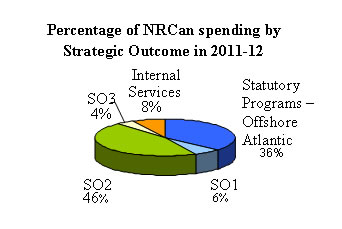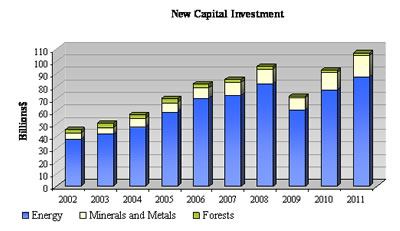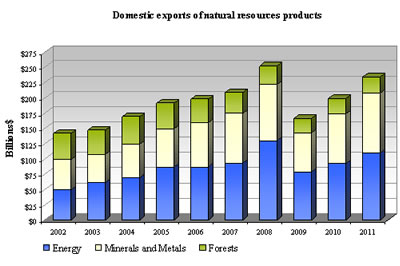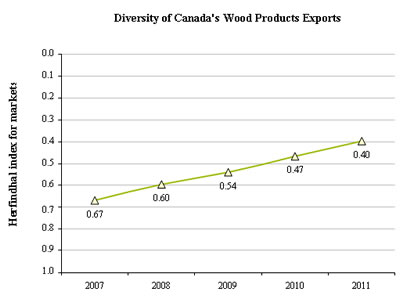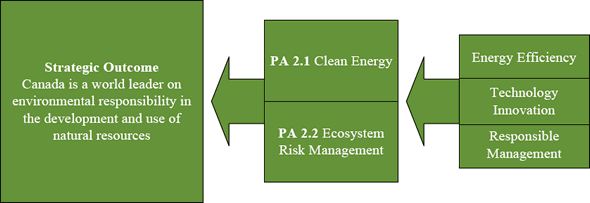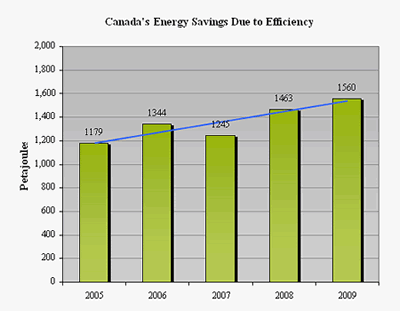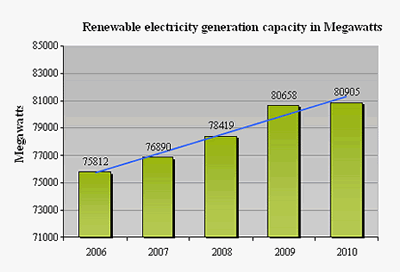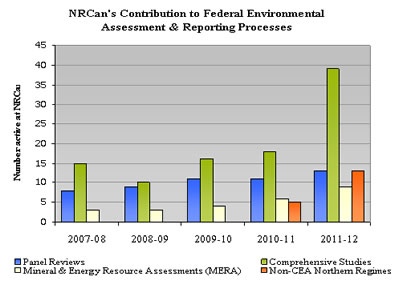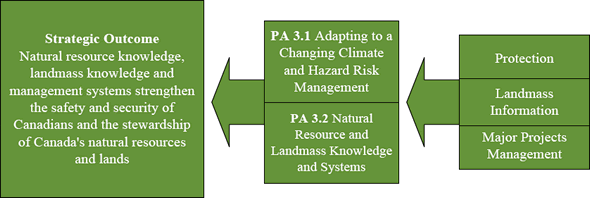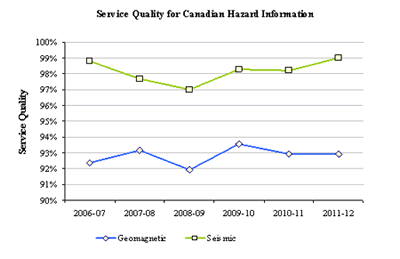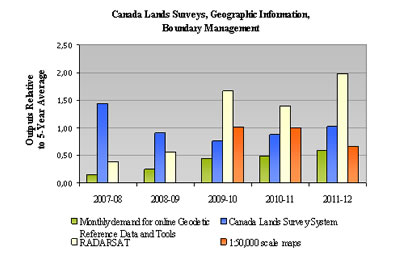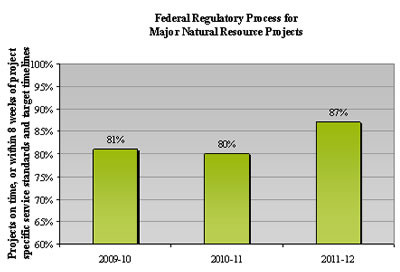Section II: Analysis of Program Activities by Strategic Outcome
This section provides performance information on the delivery of programs that were critical to the realization of our Strategic Outcomes and priorities in 2011-12. During the reporting period, NRCan monitored and tracked progress through quarterly reviews, which enabled early detection of problem areas and the implementation of corrective actions to deliver expected results in accordance with plans, timelines and budgets.
NRCan also updated its performance indicators to support improved performance management and decision-making, and to provide more accurate and balanced performance information to Parliament and Canadians. As a result, performance indicators in this document differ slightly from those published in the corresponding 2011-12 Report on Plans and PrioritiesFootnote 75.
More information about these programs and initiatives, as well as supporting evidence from internal evaluation and audit reports, can be found on our websiteFootnote 76.
Strategic Outcome 1 - Economic Competitiveness
NRCan works to advance the economic competitiveness of natural resources by:
- Diversifying export markets and reducing reliance on any single market through trade promotion and expansion of the use of traditional products;
- Maximizing productivity and the development of non-traditional products by encouraging natural resource sectors to adopt new technologies and processes and to develop new products; and
- Providing information that supports exploration and promotion of natural resources and developing policies that are conducive to investment.
Program Activity 1.1: Economic Opportunities for Natural Resources


Expected Result:
Competitive national and international markets, stable economic opportunity, and investment in natural resources
The program activity contains programs designed to promote innovation, investment and the enhancement of the competitiveness of Canada’s industries involved in natural resources and related products through the provision of know-how and tools, including base geoscience information, along with trade promotion and market acceptance, at home and abroad. This group of programs also delivers policies, regulations and legislative work to manage federal responsibilities associated with Canada’s oil and natural gas supply, protecting critical energy infrastructure, and managing statutory programs for the Atlantic offshore.
| 2011–12 Financial Resources ($ millions) | 2011–12 Human Resources (FTEs) | |||||
|---|---|---|---|---|---|---|
| Planned Spending | Total Authorities | Actual Spending | Planned | Actual | Difference | |
| Program | 185.5 | 258.4 | 216.8 | 910 | 986 | 76 |
| Statutory Programs – Atlantic Offshore Accords | 1,613.9 | 1,222.7 | 1,222.7.3 | |||
| Performance Indicator | Target | Results |
|---|---|---|
| Capital investments in the resources sector. | Favourable 10-year trend (in billions of dollars). |
Investments in new capital are expected to be $125 billion in 2012, which represents a 17% increase from 2011. The largest investment is expected to be in energy, which has rebounded to pre-recession levels. This is followed by investments related to minerals and metals and forests. |
| Domestic exports of natural resource products. | Favourable 10-year trend (in billions of dollars). |
For example, global demand for aluminum, copper, nickel and zinc is increasing and is expected to remain positive. In 2011, minerals and metals were the leading export to China and accounted for roughly a third of all commercial exports. Largely due to demand, energy exports, excluding uranium and coal, grew by 19.7% in 2011 to $109.5 billion. The export of softwood lumber to China reached an all-time high in 2011, and continued growth is expected. |
| Diversity of Canada's wood products export markets (as measured by the Herfindahl index for markets). | Favourable 5-year trend. |
This clear and positive 5-year trend demonstrates Canada’s success in diversifying end markets for Canadian wood products away from a single market. The diversity of export markets increases the resiliency of the forest sector and allows it to adapt more easily to changing market conditions. The Herfindahl Index presented here is supported by data from Statistics Canada’s World Trade Atlas. The closer the value is to 0, the more a country has diversified its exports away from a dependency on one key market. The calculation of the index takes into account the number of countries of destination markets, pro-rated based on the value of the exports. |
Performance Summary and Analysis of Program Activity
Natural resources are a key economic driver for Canada and play a fundamental role in Canada’s economy. Canada has maintained a strong economic position, due in part to the country’s large and diverse natural resource endowment and its stable investment climate. As Canada’s resource endowment and production is far larger than its domestic demand; as a result, economic growth and resource-based prosperity is supported by a strong global demand for natural resources. NRCan works to capitalize on this demand for Canada’s natural resources, particularly from emerging economies, by encouraging capital and exploration investments in this sector. As well, with growing global competition, especially in the forest sector, Canada is no longer able to rely only on traditional markets and products to remain competitive and must diversify markets through the expansion of exports and trade. NRCan supports the economic competitiveness of natural resource sectors by:
- Promoting exploration of and investment in our natural resources;
- Developing policies that are conductive to investments and market access; and
- Encouraging product diversification and innovation in the forest sector.
In 2011-12, NRCan programs encouraged natural resource investment and trade in Canada. For example, forest-related programs contributed to market diversification, the expansion of wood product applications in new market segments, and the development of value-added forest products and technologies. As well, the provision of public geoscience knowledge (focusing on the North) is required for investment and development decisions by the private sector. Finally, NRCan also worked with Aboriginal and non-Aboriginal forest-based communities to ensure that they had the expertise and tools to take advantage of emerging economic opportunities.
Key achievements in 2011-12
Encouraging Investment and Exploration
- Promoted Canada’s investment and exploration in Canada’s natural resource sector through the provision of information by the Targeted Geoscience Initiative 4 (TGI-4), which provides improved geoscience knowledge on Canada’s minerals system including exploration models, and the Geo-mapping for Energy and Minerals (GEM) program, which provides the geoscience knowledge necessary for private sector exploration companies to guide investment decisions. Specific achievements in these areas include:
- Delivering more than 50 presentations at international and domestic conferences that highlight the new ore system knowledge developed under TGI-4.
- Conducting consultations and information sessions across Northern communities to better align GEM priorities with the needs of local communities for economic development as well as providing a grant to the Arctic College, which resulted in web-based geoscience education and information.
- Developing tools that will enhance the effectiveness of exploration for deeply buried gold deposits as well as for exploration of the nickel-copper-platinum group of elements.
- Releasing new geophysical and new geochemical information to fill identified knowledge gaps about potential investment opportunities in the North.
- Encouraged investments in the minerals and metals sector by:
- Releasing a report on Taxation and Mineral Income in 2012 – How Canada Compares and other web products that raise awareness about opportunities such as Canada’s Positive Investment Climate for Mineral Capital, The Geographic Distribution of Canada’s Mining Assets, and Canadian Mineral Exploration and Deposit Appraisal.
- Working with other government departments to develop an approach supporting sustainable northern mining; this included developing a platform for sharing geospatial data and initiating the development of a series of planning tools.
- Ensured that forest-based communities have the knowledge and tools needed to take advantage of emerging economic opportunities by:
- Implementing the Aboriginal Forestry InitiativeFootnote 77 (AFI), which supported 16 projects focussed on activities such as undertaking feasibility studies, building capacity, and developing skills for business and job creation. This initiative encourages partnerships among other levels of government and has contributed to four first nations receiving funds to commence planning of local pellet and cogeneration facilities and has supported training of community members to work in the facilities.
- Producing more than 50 publications, tools and strategies that focus on topics ranging from bio-energy and climate change research to implementation of youth skills development initiatives under the Forest Communities ProgramFootnote 78. These products help forest-based communities transition to the new economy.
Improving Market Access and Product Diversification
- Helped to bolster market acceptance of Canadian wood products under the Leadership for Environmental Advantage in Forestry Initiative by developing science-based products to highlight Canada’s sustainable forest sector practices and address environmental reputation issues related to the purchase of Canadian forest products.
- Promoted Canada as a responsible natural resource supplier in various bilateral and multilateral fora, including two Ministerial missions to Asia, which resulted in an Memorandum of Understanding on Energy Cooperation between China and Canada that will attract capital investment and improve access to Chinese markets for Canada’s energy resources, technology, and related services. Substantive work was also conducted to promote Canada’s energy interests internationally, including:
- Strengthening the dialogue on energy between Canada and Norway through a Joint Ministerial Statement on Cooperation in the energy sector that will enhance commercial cooperation by energy companies;
- Supporting the Canada-Brazil Energy Dialogue to create opportunities for both countries and energy suppliers to exchange experiences and technology;
- Participating in several international energy fora, including Ministerial meetings at the International Energy Agency and International Energy Forum; and
- Providing advice and recommendations on energy-related issues with the United States including development, in collaboration with the United States Department of Energy, of an action plan for the second phase of the Clean Energy Dialogue. This includes collaboration, through a working group, on key clean energy and technology areas such as carbon capture and storage (CCS) to advance CCS research, development and demonstration.
- Enabled the competitiveness of the energy and mining sectors by supporting the Government of Canada in securing an agreement with other levels of government on a collaborative approach to energy, and contributing to the development of work plans within the Council of Energy and Mines Ministers.
- Bolstered acceptance of Canadian energy resources by working collaboratively with the Task Force on Energy Security, Prosperity and Sustainability to communicate the contribution that energy resources from the oil sands make to the economy, energy security, international trade, and environmental responsibility and sustainability.
- Improved the market access and diversification of Canada’s wood products through a suite of programs including the Canada Wood Export Program (CWEP), the North American Wood First Initiative (NAWFI), and the Value to Wood Program (VWP). The programs were provided an additional year of funding in Budget 2011 to help the forest industry to diversify and expand markets for its products. Specific achievements included:
- Helping expand exports to countries such as China and Korea, through the CWEP. It also contributed to the promotion of non-traditional uses of wood products through a memorandum to understanding on Eco-cities with China’s Minister of Housing and Urban-Rural Development, which calls for Canada-China cooperation to develop eco-cities technology in a number of areas, including energy-efficient buildings and the use of wood in multi-story buildings.
- Continuing to increase the use of wood in the non-residential sector in Canada and the United States through the provision of education, promotion and technical advice under NAWFI, which directly influenced the choice of wood in almost 352 non-residential building products, representing $130.3 million of wood product sales.
- Funding 27 research projects at 5 research organizations across Canada through VWP, which generated new and improved wood products and processes by the secondary wood products manufacturing sector, and provided technical support to close to 160 small- and medium-sized wood manufacturers to enable process and competitive improvements in all their operations.
- Encouraged research and innovation in the forest sector through the Transformative Technologies Program (TTP), administered by FPInnovations, along with the Investments in Forest Industry Transformation (IFIT) program and the Forest Innovation by Research and EducationFootnote 79 (FIBRE) initiative. These initiatives support research, innovation and the development of highly qualified personnel to allow for the development of diverse and innovative wood products and technologies. Key achievements included:
- Enabling the commercial-scale production of nanocrystalline cellulose through funding received under the TTP and the Pulp and Paper Green Transformation Program. This high-value bioproduct has a variety of potential uses, including aerospace structures, pharmaceuticals, security papers and cosmetics. Funding was provided to the TTP program in Budget 2011 to further support the development of emerging and breakthrough technologies.
- Signing contribution agreements for 4 transformative projects, generating $17.7 million in investments in first-in-Canada innovative technologies through the IFIT program. These projects focus on the production of new engineered wood products, bioproducts and bioenergy. These innovative new products and technologies ensure a more diverse, higher-value mix of products and renewable energy in Canada’s forest sector.
- Supporting the development of FIBRE, launched in fall 2011, which builds synergies among eight forest research and development networks in support of the priorities of Canada’s forest sector innovation system.
Lessons Learned
Forest Products Market Development Programs
An evaluationFootnote 80 of the Forest Products Market Development Programs was completed in 2011, which included the Canada Wood Export Program, the North American Wood First initiative, and the Value to Wood Program. The evaluation confirmed the need for these programs and that they are effectively responding to the needs of Canada’s forest sector. These programs received additional funding in Budget 2011 to continue to deliver on their results of expanding markets for wood products. An area highlighted for continued improvement was to ensure more equitable opportunities for wood products industry associations to participate in the Canada Wood Export Program and the North American Wood First Initiative and to provide more flexibility in the funding mechanisms.
Securing Forest Products Markets: International Influence
In 2011-12, an evaluationFootnote 81 was also conducted on Securing Forest Products Markets: International Influence, which included the Leadership for Environmental Advantage in Forestry (LEAF) Initiative, International Forestry Partnerships Program, and the Economic Action Plan demonstration projects. The evaluation found that domestic and international demonstrations were well delivered with partners. In addition, the evaluation recommended that NRCan develop a comprehensive coordinated approach that clearly communicates the role of different stakeholders and integrates market access and development programs. In response, the administrative functions of all market programs were merged, and environmental reputation work was integrated with other market activities.
Links with the Federal Sustainable Development Strategy (FSDS)
NRCan’s Economic Competitiveness activities provide support to Theme I (Clean Air) and Theme III (Protecting Nature) of the FSDS through projects on minerals and metals (1.1.1). As well, forest product market development activities that support forest sector innovation (e.g., IFIT) are providing alternatives to non-renewable products and energy sources through the development of new bioproducts, bioenergy and next-generation wood products (1.1.3). Participation in key international fora and international climate change negotiations in order to represent Canada’s energy interests (1.1.7) also contributes to Theme I (Clean Air).
Strategic Outcome 2 - Environmental Responsibility
NRCan works to ensure that natural resources are developed and used in an environmentally responsible manner by:
- Encouraging and enabling energy consumers and producers to adopt cleaner and more efficient technologies, products, and practices;
- Encouraging academia, industry and the public sector to research, develop, and demonstrate innovative solutions to environmental challenges; and
- Enabling government departments, regulatory bodies and industry to understand the risks to the environment, assess environmental impacts, and protect Canada’s resources.
Program Activity 2.1: Clean Energy

Expected Result:
Increased energy efficiency, increased production of low-emission energy, and reduced environmental impacts associated with energy
The program activity includes the development and delivery of energy science and technology, policies, programs, legislation and regulations to mitigate greenhouse gas emissions and to reduce other environmental impacts associated with energy production and use. One of the major programs is the suite of initiatives on clean energy announced under the banner of ecoENERGY, which is intended to increase production of low-impact renewable energy; encourage and help Canadians in improving their energy use in all of the major end-use sectors; and to accelerate the development and market readiness of technology solutions to reduce environmental impacts associated with the production and use of energy.
| 2011–12 Financial Resources ($ millions) | 2011–12 Human Resources (FTEs) | ||||
|---|---|---|---|---|---|
| Planned Spending | Total Authorities | Actual Spending | Planned | Actual | Difference |
| 1,327.3 | 1,745.0 | 1,323.3 | 796 | 906 | 110 |
| Performance Indicators | Target | Results |
|---|---|---|
| Canada's total annual energy savings due to efficiency (difference between energy use without energy efficiency improvements and energy use with energy efficiency improvements). | Favourable 5-year trend in energy saved (in petajoules [PJ]). |
From 2005 to 2009 (the most recent year for which data are available), energy savings due to energy efficiency in Canada increased by 381 petajoules (PJ). This represents a significant increase in energy savings over that time period. Since 2005, energy efficiency improvements were made in the residential, commercial/institutional and transportation sectors with a combined 23% gain in energy savings. Improvements in industrial sector were even more significant, with a 51% gain in energy savings. A smoothing of the energy efficiency trend can be seen compared to last year's report. This is a result of a change in the factorization process that identifies the improvements in energy efficiency that occurred in the Canadian economy. More details on this change as well as information on trends in energy use and energy efficiency in the residential, commercial/institutional, industrial, and transportation sectors can be found in the report Energy Efficiency Trends in Canada 1990-2009Footnote 82 and the Energy Efficiency Trends Analysis Tables Footnote 83. |
| Renewable electricity generation capacity. | Favourable 5-year trend in electricity generation capacity against a baseline year of 2005 (in megawatts [MW]). |
The distribution of renewable electricity generating sources differs across Canada based on regional renewal energy sources. As a result, some provinces having substantial hydro-electric capacity while others are focussed on harnessing the potential of biomass, solar, wind and tidal energy. |
Performance Summary and Analysis of Program Activity
As the world transitions to a lower-carbon economy, clean energy will play an increasingly important role in this transition. NRCan supports this transition by encouraging and enabling energy consumers and producers to adopt cleaner and more efficient technologies, products, and practices. Through its programs, it encourages improved energy efficiency, increased production and use of renewable and alternative energy, and the development of clean energy technologies.
In 2011-12, NRCan worked in collaboration with industry, academia, other government departments and regulatory bodies to reduce the environmental impact associated with energy production and use. In addition, the ecoENERGY initiatives were renewed in Budget 2011 including activities on energy efficiency and ecoENERGY Retrofit – Homes as well as clean energy research, development and demonstration.
Key Achievements in 2011-12
- Improved energy efficiency in Canada, through the renewed ecoENERGY Efficiency program, which achieved an energy savings of more than 5 petajoules in 2011-12. Key accomplishments for the ecoENERGY Efficiency program included:
- Training more than 218,300 individuals in energy efficiency products and practices (i.e., 210,000 new drivers, 4,300 fleet drivers, 1,250 building sector professionals, 1,950 industry sector professionals, and 800 housing sector professionals).
- Publishing the National Energy Code for Buildings 2011, for adoption/adaptation by provinces and territories, in November 2011. The code establishes an overall 25% improvement in energy efficiency in comparison to the previous code and places Canada on a comparable footing with other countries that lead in energy-efficient building construction.
- The ecoENERGY Retrofit – Homes program reached its 2011-12 target of 250,000 registrants, and provided incentives to eligible homeowners to make their homes more energy efficient.
- Reached the ecoENERGY Retrofit – Homes program target of 250,000 registrants, and provided incentives to eligible homeowners to make their homes more energy efficient, achieving an energy savings of more than 4 petajoules per year.
- Encouraged the production of renewable energy through ecoENERGY for Renewable PowerFootnote 84, ecoENERGY for Biofuels, and the Pulp and Paper Green Transformation Program. Specific achievements in these areas included:
- ecoENERGY for Renewable Power, which encourages the production of clean electricity from renewable sources, is fully subscribed and has exceeded its target of 4,000 MW of renewable electricity production capacity. It has signed 104 contribution agreements, representing 4,458 MW of renewable power production capacity.
- ecoENERGY for Biofuels, which provides operating incentives to producers of renewable alternatives to diesel (i.e., biodiesel) and gasoline (i.e., ethanol), has signed 30 contribution agreements, which represent almost all of the targeted biodiesel capacity of 500 million litres but falls just short of the targeted ethanol capacity of 2 billion litres. Challenges remain, however, because biodiesel production by producers is not coming on-line as expected due to several factors such as economic conditions and the preferences of fuel providers.
- The Pulp and Paper Green Transformation Program signed agreements for 21 projects in 2011-12, resulting in the program surpassing its targets for renewable energy production and energy efficiency improvements. As a whole, this program has provided funding for 98 projects in 38 communities across Canada, with program contributions totalling $950 million. The program is expected to add nearly 200 MW of capacity to generate renewable electricity and save 8.5 million GJ of energy annually.
- Established, through the ecoENERGY for Alternative FuelsFootnote 85 program, two new committees that are actively working on developing and updating the codes and standards for liquid and compressed natural gas vehicles and refuelling stations.
- Increased innovation through Clean Energy Science and Technology and Materials for Energy activities, which have advanced the development of knowledge and technologies to enable a transition to a clean energy economy and to reduce greenhouse gas emissions. Some key highlights in 2011-12 included:
- Launching the ecoENERGY Innovation Initiative, which builds on the past success of the Clean Energy Fund and the ecoENERGY Technology Initiative. A successful Request for Project Proposals (RFPs) process with a newly established expert review committee resulted in 111 projects from 159 proposals being selected for research and development (R&D) by federal departments in the first year of the program. An additional 139 future projects were selected from 460 proposals for federal R&D and external R&D and demonstration.
- Furthering research, development and demonstration on carbon capture and storage (CCS) with industry partners and expanding geoscience through contribution agreements with:
- SaskPower for a pilot-scale demonstration project at the Shand Power plant to reduce the cost and increase the efficiency of CCS in coal-fired electricity;
- The Petroleum Technology Research Centre for the Aquistore project, which will demonstrate safe storage of carbon dioxide in a deep saline formation; and
- The development of the North American Carbon Storage AtlasFootnote 86 that identifies all major sources of carbon dioxide emissions and potential geological reservoirs for storage and estimated capacity in Canada, Mexico, and the United States.
- Developing new materials to support energy improvements in the next generation of nuclear reactors (GEN IV) and for the transportation industry in collaboration with partners. New high-temperature materials (e.g., ceramic based insulators and coatings) were developed for GEN IV, and can be used in other energy applications. New transportation materials were developed that support energy efficiency improvements such as cast aluminum alloys for improved engine design, which are ready to transfer to commercial applications as well as magnesium-based technologies for lightweight structural materials developed through a collaborative Canada-US-China project.
- Working in collaboration with Canada Mortgage and Housing Corporation on the Equilibrium Communities Initiative to focus research on improving designs and planning by developers in key theme areas (energy, water, land use, transportation, and natural environment), which resulted in forecasted reductions in energy and water demand and improvements in the use of waste heat.
- Launching the ecoENERGY Innovation Initiative, which builds on the past success of the Clean Energy Fund and the ecoENERGY Technology Initiative. A successful Request for Project Proposals (RFPs) process with a newly established expert review committee resulted in 111 projects from 159 proposals being selected for research and development (R&D) by federal departments in the first year of the program. An additional 139 future projects were selected from 460 proposals for federal R&D and external R&D and demonstration.
Links with the Federal Sustainable Development Strategy (FSDS)
The Clean Energy program activities provide significant support to Theme I (Clean Air) of the FSDS, specifically to Goal 1.1 to reduce greenhouse gas emissions, and contribute indirectly to Goal 1.2 to improve air quality. Key highlights of the contribution to these goals include:
- Improving energy efficiency in Canada through the provision of training, information, and tools on energy efficient products and practices in several target sectors (housing, buildings, equipment, industry, and transportation) as well as the enhancement of energy efficiency regulations. In addition, supporting domestic production capacity of renewable fuels in support of Environment Canada’s Renewable Fuels Regulations. (2.1.4)
- Encouraging the development of a clean electricity system under the ecoENERGY for Renewable Power program, which is projected to result in the reduction of carbon dioxide emissions of between 6.0 and 6.7 Mt. (2.1.2) and enabling Canada’s pulp and paper industry to reduce its GHG emissions by more than 10% from 2009 levels by funding projects that increased mills’ capacity to generate renewable electricity and their ability to utilize biomass as an energy source, thereby reducing their overall energy consumption. (2.1.5)
- Taking concrete actions to reduce GHG emissions and air pollutants by investing in clean energy RD and demonstration (i.e., CCS, Equilibrium Communities Initiative). (2.1.3) As well as developing new high-temperature materials that can be used in fossil power and petrochemical systems to improve thermal efficiency and lower emissions, and new lightweight and structural materials for improved engine design and automotive applications with the goal of improving the efficiency of engine combustion as well as fuel efficiency. (2.1.1)
Program Activity 2.2: Ecosystem Risk Management



Expected Result:
Canada understands and mitigates risks to natural resource ecosystems and human health
The program activity includes programs that help to understand the risks to our environment and the protection of critical resources such as groundwater. A major initiative is the National Forest InventoryFootnote 87, which is designed to provide information to provinces, territories, other collaborators and the public on the state of Canada’s forests and to demonstrate how forest attributes are changing over time.
| 2011–12 Financial Resources ($ millions) | 2011–12 Human Resources (FTEs) | ||||
|---|---|---|---|---|---|
| Planned Spending | Total Authorities | Actual Spending | Planned | Actual | Difference |
| 87.0 | 226.7 | 199.1 | 419 | 383 | (36) |
| Performance Indicators | Target | Results |
|---|---|---|
| NRCan's contribution to federal environmental assessments, and forest, mineral and energy resource assessments for proposed protected areas on federal lands and waters, and related reporting processesFootnote 88. | Fulfilling on-demand requirements |
In a similar fashion, NRCan contributed its expertise, such as economic and mineral development analysis when considering lands for exclusion as having potential strategic minerals as part of the Mineral and Energy Resource Assessments (MERA) process for the establishment of reserves, national parks, and other protected areas. This included delivery of all three requested resource assessments for Marine Protected Areas. |
Performance Summary and Analysis of Program Activity
Risks related to natural resource ecosystems and human health are an increasingly important issue both domestically and internationally. NRCan plays a key role in supporting environmental responsibility in the development and use of natural resources through the dissemination of knowledge (e.g., forest ecosystems characteristics), innovation in green mining, strong environmental assessment processes and radioactive waste management to mitigate ecosystem risks.
Key Achievements in 2011-12
- Improved the understanding of forest management activities on forest ecosystems by providing scientific knowledge to manage risks and minimize the impact of forest resource development through the:
- Continued development of the National Forest Carbon Monitoring, Accounting and Reporting SystemFootnote 90 used for estimating forest-related carbon stock changes and greenhouse gas emissions. This work included the addition of a model to estimate carbon in harvested wood products and contribution to the UN Framework Convention on Climate Change.
- Publication on the internet of the National Forest Inventory (NFI), which enables Canadians to access and query map products, including information on stewardship of forest resources. This work included important updates on new economic and biophysical information on Canada’s forests to support policy development and to provide science-based information on forest sustainability.
- Continued development of the National Forest Carbon Monitoring, Accounting and Reporting SystemFootnote 90 used for estimating forest-related carbon stock changes and greenhouse gas emissions. This work included the addition of a model to estimate carbon in harvested wood products and contribution to the UN Framework Convention on Climate Change.
- Continued to reduce the environmental impacts of mining through the Green Mining Initiative in collaboration with partners. For example, the Green Mining Initiative:
- Delivered on the first phase of the Ventilation on Demand project, including the introduction and commercialization of hybrid production vehicles, with the Canadian Mining Innovation Council and industry;
- Initiated studies on ore sorting technology to reduce waste generation and energy consumption in mineral processing as well as identifying environmental challenges associated with mining specific ore deposit(s) in the Northern context;
- Completed a multi-stakeholder workshop to assess regulatory barriers to green mining; and
- Completed a multi-stakeholder workshop under the National Orphaned and Abandoned Mines InitiativeFootnote 91 (NOAMI), exploring the management and long-term liabilities of the relinquishment of mining lands to the Crown.
- Delivered on the first phase of the Ventilation on Demand project, including the introduction and commercialization of hybrid production vehicles, with the Canadian Mining Innovation Council and industry;
- Established long-term management solutions for radioactive waste for which the federal government has responsibility. During 2011-12, NRCan was instrumental in:
- Facilitating the Implementation Phase of the Port Hope Area Initiative, for which the government announced approval in January 2012. The clean-up phase will be carried out through two projects to address radioactive wastes – Port Hope Project and Port Granby Project. The implementation of the Port Granby Project has been fully approved and licensed, and acquisitions were made for a new waste management facility. The Port Hope Project has also been approved.
- Meeting government-approved program milestones for the second phase of the Nuclear Legacy Liabilities Program (NLLP). The NLLP, which aims to safely and cost-effectively reduce legacy liabilities and associated risks at Atomic Energy of Canada Limited sites, achieved all 17 of its milestone with 2 achieved ahead of schedule. This included activities such as the substantial completion of waste management infrastructure at Chalk River Laboratories with the construction of a fuel packaging and storage facility as well as a new shield construction at the Whiteshell Laboratories.
- Facilitating the Implementation Phase of the Port Hope Area Initiative, for which the government announced approval in January 2012. The clean-up phase will be carried out through two projects to address radioactive wastes – Port Hope Project and Port Granby Project. The implementation of the Port Granby Project has been fully approved and licensed, and acquisitions were made for a new waste management facility. The Port Hope Project has also been approved.
- Divested the AECL CANDU Reactor Division with its continued operation to Candu Energy Inc., a wholly owned subsidiary of SNC-Lavalin. Through the sale in October 2011 to SNC-Lavalin, the Government has delivered on its objective to achieve the best deal possible for AECL’s commercial arm, its employees, the nuclear industry and Canadians while contributing to maintaining the CANDU technology as a safe, effective, and low-emission energy option. Progress was also made on the restructuring of AECL’s Nuclear Laboratories in 2011-12.
- Contributed to the federal environmental assessment and reporting process by providing expertise and knowledge to support sustainable and environmentally responsible resource development. Specifically, new geoscience research was conducted to support the environmental impact assessment of mining, covering a range of strategic mineral resources in the Northwest Territories and Nunavut. As well, research activities were conducted within the Environmental Geoscience Program to improve and inform the assessment of environmental impacts.
- Completed mapping and characterization of three Canadian aquifers, which contributed to the longer term target of the mapping and assessment of seven aquifers by March 2014. Groundwater geoscience is conducted in collaboration with provinces and territories to support sound decision-making on groundwater management issues by government, industry and Canadians.
Lessons Learned
Port Hope Area Initiative
The Port Hope Area Initiative (PHAI), a community-based initiative established to develop and implement a safe, local, long-term management solution for historic low-level radioactive waste in the Port Hope area, was also evaluated in 2011-12. The evaluationFootnote 92 found that PHAI remains relevant, is addressing an ongoing need, and is conducted in a cost-effective manner, considering regulatory requirements, public perception and best available technology. As a result of the evaluation, NRCan has:
- Developed several frameworks aimed at resolving issues related to both PHAI technical issues and communication ties with the local communities.
- A Municipal Expediting Team (MET) will be established in the Municipality of Port Hope to facilitate consultations among the PHAI Management Office (MO), contractors and municipal staff to expedite project completion.
- Launched an independent assessment of the terms and conditions of the Property Value Protection program; this assessment will be used to strengthen the eligibility criteria to increase the effectiveness of the program.
NRCan and the PHAI MO will produce a communications program for residents in the communities to ensure the revised terms and conditions are well understood. Finally, a review of property files and resurvey of Port Hope properties is being undertaken to improve the level of site characterization and to mitigate later risks associated with the discovery of new contamination.
Nuclear Legacy Liabilities Program
In 2011-12, an evaluationFootnote 93 was conducted on the Nuclear Legacy Liabilities Program, which is a program that is implemented through a memorandum of understanding between NRCan and AECL. The evaluation concluded that there is an environmental and regulatory need for the Program, and that it is consistent with and supports the federal government’s priorities, as well as NRCan’s strategic objectives.
Based on the recommendations of the evaluation, NRCan has strengthened its oversight of the NLLP. For example:
- An ADM-level Steering Committee has been established that includes senior NRCan, AECL, and Canadian Nuclear Safety Commission representatives to provide strategic oversight.
- NRCan has increased its presence at AECL sites through site visits and participation in project-level meetings and workshops.
- A new monthly reporting requirement has been instituted, which includes key program metrics, summaries of progress, issues and mitigating actions. As well, risk management.
As well, risk practices have been improved, and AECL is implementing an action plan to enhance its procurement processes to support NLLP outsourcing requirements.
Links with the Federal Sustainable Development Strategy (FSDS)
Ecosystem Risk Management activities, specifically Forest Ecosystem Science and Adaptation (2.2.2), support Theme III (Protecting Nature). NRCan is the lead on FSDS Target 7.3 (Sustainable Forest Management) to improve the management of Canada’s forest ecosystems through the development and dissemination of knowledge, detailed further below. This theme is also supported by contributions to federal environmental assessment processes for national parks and other protected areas. (2.2.3)
Activities such as radioactive waste management through the Port Hope Area Initiative and Groundwater Geoscience support FSDS Theme II (Maintaining Water Quality and Availability). Key highlights of contributions to this area include:
- Supporting the management of Canadian Areas of Concern in the Great Lakes by responding to community-recommended solutions for the clean-up and long-term safe management of historic low-level radioactive waste. (2.2.4)
- Improving the knowledge of Canada’s aquifers through mapping and assessment to provide knowledge and support improved water management practices as well as supporting sound assessments of marine conservation areas. (2.2.3)
As well, activities in this area contributed to Theme I goals of reducing GHG emission and improving air quality, such as the Green Mining Initiative, which is encouraging the use of alternative energy vehicles in the mining sector, promoting the use of clean-diesel technology, and supporting the development of bio-energy feedstocks. (2.2.1)
Programming in this area that contributes to the Federal Sustainable Development Strategy (FSDS)
The Target 7.3 results supported by NRCan’s sub-activity 2.2.2 Forest Ecosystems Science and Applications include:
| FSDS Goal | FSDS Performance Indicator | FSDS Target | FSDS Actual Results |
|---|---|---|---|
| 7 Biological Resources | Number of peer reviewed publications related to forest ecosystems (*) | 3 Sustainable Forest Management - Improve the management of Canada’s forest ecosystems through the development and dissemination of knowledge (**) |
NRCan continues to increase scientific knowledge on forest ecosystems by contributing to knowledge for stakeholders on forest sustainability, which helps to improve Canada’s environmental reputation and benefits our economic competitiveness. NRCan produced 224 peer-reviewed publications over the three years in question (fiscal years 2009-10 to 2011-12). This indicator was extracted from the NRCan Performance Measurement Framework. This indicator was designed to enable NRCan’s scientific work to inform clients and stakeholders on sustainable forest management practices. Generating and disseminating scientific knowledge related to forest ecosystems is based on publications that have been peer reviewed. Peer reviewed publications are the accepted standard for ensuring that the analysis is scientifically sound, and for informing policy grounded in sound science. |
|
* NRCan does not share responsibility for this indicator with any other department. ** NRCan does not share responsibility for this target with any other department. |
|||
Strategic Outcome 3 - Safety, Security and Stewardship
NRCan works to ensure the safety and security of Canadians and the stewardship of their natural resources by:
- Contributing to the mitigation of risks associated with the effects of climate change and hazards, such as wildfire, earthquakes, and floods;
- Supporting an improved understanding of the Canadian landmass, geography, and boundaries as well as collaboration on the North to encourage sustainable resource development and protection of the North; and
- Improving the efficiency and the effectiveness of the federal regulatory review process for major projects.
Program Activity 3.1: Adapting to a Changing Climate and Hazards Risk Management

Expected Result:
Canada adapts to a changing climate and has the knowledge and tools to manage risks associated with natural hazards and hazards arising from human activities
The program activity provides geoscience and geospatial information that contributes to the reduction of risks from natural hazards, such as earthquakes, tsunamis and floods, as well as hazards arising from human activities, and works with front-line responders to provide geographical information in the event of an emergency. The program activity also provides information that will help Canadians mitigate and adapt to the effects of a changing climate and enforces the Explosives ActFootnote 94
| 2011–12 Financial Resources ($ millions) | 2011–12 Human Resources (FTEs) | ||||
|---|---|---|---|---|---|
| Planned Spending | Total Authorities | Actual Spending | Planned | Actual | Difference |
| 63.6 | 55.4 | 50.8 | 552 | 436 | (116) |
| Performance Indicators | Target | Results |
|---|---|---|
| NRCan's contribution to natural hazard risk management as measured by the timeliness and accessibility of natural hazard risk management knowledgeFootnote 95. | Greater than 90% of natural hazard data meet timeliness and accessibility standards. |
The provision of this information helps other levels of government, international government bodies, the private sector and professional organizations to prepare for and mitigate natural disasters and make decisions for the effective management of Canada’s lands. |
Performance Summary and Analysis of Program Activity
Governments need information about the effects of climate change to better understand how to adapt to it. Collaboration among decision-makers at different levels must then be facilitated to allow for the identification of mitigation strategies and long-term planning for different regions (e.g., North) and natural resource sectors.
A number of programs under this program activity provided knowledge on climate change and successfully brought together different levels of government in 2011-12.
Key Achievements in 2011-12
- Pre-published new proposed explosives regulations in the Canada Gazette on March 17, 2012Footnote 98. The regulations cover a wide range of explosives from fireworks to model rockets to blasting explosives.
- Facilitated collaboration on climate change adaptation and planning by:
- Delivering 27 workshops and conference sessions, through six Regional Adaptation Collaboratives (RACs), which brought together decision-makers from all levels of government and the private sector to share knowledge and expertise to advance adaptation decision-making on issues such as water management, community planning, infrastructure, forest management, and mining. The information and recommendations from RAC projects contributed to the development of policies, including provincial climate adaptation guidelines for Nova Scotia’s municipalities and adaptation plans to address floods and droughts in Saskatchewan and other provinces.
- Completing a state-of-the-art knowledge synthesis on assisted tree migration, establishing a pan-Canadian forestry adaptation community of practice, and conducting national workshops and webinars with forest managers to accelerate the incorporation of climate change adaptation into forest management policies and practices in Canada.
- Building on the success of the RACs initiative, the Climate Change and Adaptation Program launched the Adaptation Platform in March 2012. The platform brings together governments, the private sector and other stakeholders to share information, experience and expertise, generate new insights and knowledge and identify opportunities for adaptation actions.
- Initiating three projects in Spring 2011 to produce geoscience knowledge and information to be used by governments (e.g., Northwest Territories, Nunavut) and stakeholders (e.g., highway and airport managers) to reduce risk to northern infrastructure and help develop adaptation measures to climate change.
- Delivering 27 workshops and conference sessions, through six Regional Adaptation Collaboratives (RACs), which brought together decision-makers from all levels of government and the private sector to share knowledge and expertise to advance adaptation decision-making on issues such as water management, community planning, infrastructure, forest management, and mining. The information and recommendations from RAC projects contributed to the development of policies, including provincial climate adaptation guidelines for Nova Scotia’s municipalities and adaptation plans to address floods and droughts in Saskatchewan and other provinces.
- Delivered essential geographic and geoscience information and support, most notably in the area of public safety geoscience, which included:
- Using scientific research to inform Canadians of the risks associated with both natural (e.g., earthquakes) and man-made hazards (e.g., explosives) and how to adapt to them. Scientific expertise was also used to inform policies and regulations to protect the population from hazards.
- Improving the ability to respond to the public interest on earthquakes by providing up-to-date earthquake information through Twitter and other forms of social media. Also, the Earthquakes Canada web-presence was moved to a high-capacity commercial content delivery system.
- Improving NRCan’s Wildland Fire Information SystemFootnote 99, which had 107,000 hits in 2011 from a range of users, including citizens, researches, and news operations (e.g., CBC, Global News, The Weather Network), which use the system to monitor fire activity and risks, aid fire operations, and conduct research. Specifically, it was improved by adding the Spatial Fire Management System that allows provinces and territorial fire management agencies to modify the system to their particular needs. In addition, an enhanced fire danger rating system was developed to predict fire impacts on biomass and vegetation response in western North American forests. Fire impact monitoring was also improved by the development of a national reporting system.
- Using scientific research to inform Canadians of the risks associated with both natural (e.g., earthquakes) and man-made hazards (e.g., explosives) and how to adapt to them. Scientific expertise was also used to inform policies and regulations to protect the population from hazards.
- Continued forestry research that informs risk analysis, mitigation and control methods for high-priority native and alien forest insects and disease. The resulting advice, tools and knowledge have enabled the Government to improve surveillance, detection, identification, mitigation and control of pests. Examples of accomplishments are:
- The pending declaration of eradication of the Asian Long Horned Beetle from Toronto, where the beetle was discovered in 2003;
- The development of climate prediction maps for Spruce Budworm and Mountain Pine Beetle infestation risks, which assist provinces in optimizing their mitigation control means;
- A biological pesticide against the Emerald Ash Borer; and
- A rapid detection method of the plant pathogen causing sudden oak death.
- The pending declaration of eradication of the Asian Long Horned Beetle from Toronto, where the beetle was discovered in 2003;
Lessons Learned
Climate Change Geoscience and Adaptation (CCGA)
In 2011, an evaluationFootnote 100 was conducted on the Climate Change Geoscience and Adaptation (CCGA) sub-activity. This sub-activity assists Canadians in understanding, preparing for, and adapting to the effects of a changing climate on their communities, infrastructure and way of life. The evaluation found that the programs are highly relevant, address ongoing needs and are making progress toward their outcomes. The evaluation also found that the relevance and effectiveness of the Climate Change Geoscience program could be increased through improved collaboration with the Impacts and Adaptation program and other NRCan programs.
In response to the evaluation findings, the Climate Change Geoscience Program component of the sub-activity improved its collaboration by participating with NRCan’s Energy Sector in the Beaufort Regional Environmental Assessment, which includes the creation of a Coastal Geoscience Data Inventory relevant to hazards and Climate Change Impacts for Coastal Infrastructure on the Beaufort Sea coast. The Adaptation program enhanced linkages through the creation of the Adaptation Platform, which will enable collaboration on adaption between government, business, and professional organizations across the country through the development and exchange of information, tools, and expertise. Work done through the Platform will also create value-added products to integrate, showcase and transfer the results and learning from the previous Adaptation program initiatives.
Forest Disturbances Science and Application
In 2011, an evaluationFootnote 101 was completed on the Forest Disturbances sub-activity, which includes the Forest Invasive Alien Species Program, National Forest Pest Strategy Footnote 102 Program, the Federal Response to Mountain Pine Beetle Program Footnote 103, and the Wildland Fire–S&T Program. The evaluation found that there is a clear rationale for the Forest Disturbances programs and that they were delivered efficiently and have produced outputs that help address the environmental and economic consequences of climate change, fire, and pests. It recommended that NRCan ensure that its forest disturbances research take into account new variables, such as climate change and other important factors, and also includes mitigation options as appropriate. Existing research within NRCan comprises work on climate change, including the interaction between events such as pest infestations and forest fires.
A revised strategic plan for Forest Disturbances has been developed and ensures that new variables in forest disturbances, such as climate change, will be taken into account in Forest Disturbances research and where possible mitigation options will be developed. Provincial partners have also been engaged, which will provide an opportunity for ensuring that research and response take into account new parameters and options for mitigation. As a result, forest sector players have state-of-the-art tools and techniques needed to assess risks, vulnerabilities and opportunities as well as to identify thresholds and develop environmentally sound responses for fire and pests and adaptation options for climate change (adaptation to climate change is any activity that reduces the negative impacts of climate change and/or takes advantage of new opportunities that may be presented).
Links with the Federal Sustainable Development Strategy (FSDS)
Natural Resource and Landmass Knowledge and Systems activities, specifically the work done under Forest Disturbances Science and Application Program, supports Theme III (Protecting Nature) by helping to manage threats to ecosystems, and aims to reduce new invasive species entering Canada by 2015. (3.1.2)
Program Activity 3.2: Natural Resources and Landmass Knowledge and Systems


Expected Result:
Government has the necessary natural resources and landmass knowledge and systems required to both govern the country and position Canada to play a leadership role in federal/provincial/territorial and international fora.
This program activity carries out the Minister’s obligation to provide a property rights infrastructure on all lands for which the department has this responsibility, along with the provision and access to accurate and precise geographic information on the Canadian landmass. The program activity also includes the Major Projects Management Office which, along with other programs, provides relevant accurate, timely and accessible knowledge with a view to increasing collaborative efforts with other jurisdictions in key areas (e.g., regulatory efficiency) to generate improved approaches to shared issues and to advance the interests of the natural resource sector both domestically and internationally.
| 2010–11 Financial Resources ($ millions) | 2010–11 Human Resources (FTEs) | ||||
|---|---|---|---|---|---|
| Planned Spending | Total Authorities | Actual Spending | Planned | Actual | Difference |
| 84.4 | 94.2 | 87.2 | 616 | 559 | (57) |
| Performance Indicators | Target | Results |
|---|---|---|
| NRCan's contribution to the development and security of Canada through advancements in geographic knowledge, boundary management, and surveys, and supporting systems for secure land tenure of Canada Lands. | Fulfilling on-demand requirements. |
The outputs of these programs and activities are used by Aboriginal groups, land management specialists, other government departments and Canadians in support of sustainable land use management. |
Performance Summary and Analysis of Program Activity
Evidence-based geographic knowledge and information is essential to support decision-making in key economic, environmental, and social activities, including the development of natural resources. For example, without such knowledge, boundaries could not be determined, authoritative land management and development could not be undertaken, and sovereign rights could not be upheld. Geographic information and derived products are made accessible to the Canadian public and private sectors.
In 2011-12, programs under this program activity accumulated new geographic and landmass information particularly with respect to the North. Progress was also made towards meeting obligations under the United Nations Convention on the Law of the Sea and the Polar Continental Shelf ProgramFootnote 106 (PCSP).
Key Achievements in 2011-12
- Produced 612 topographic maps at the 1:50,000 scale covering parts of Nunavut and Northwest Territories exceeding the original intent to produce 500 maps. This achievement has significantly contributed to the knowledge about potential economic opportunities in these areas. Knowledge of the North was further bolstered by the completion of annual obligations for land claim surveys, including the survey of 97 kilometres of boundary for the Tlicho Land Claim and 427 kilometres of boundaries for 14 parcels pursuant to the Yukon Land Claims Agreement. There has was also an increase in the downloading of both satellite imagery (by 42%) and geodetic data (by 23%) as compared to the 2010-11 baselines, indicating an increased understanding of the Canadian landmass.
- Prepared coordinates for the Atlantic and continued to develop those for the Arctic under the United Nations Convention on the Law of the Sea to determine with precision the areas in the Arctic and Atlantic Oceans where Canada may exercise its sovereign rights over the natural resources on the continental shelves.
- Delivered on the collaborative agreement between the Polar Continental Shelf Program and the Department of National Defence to establish a Canadian Forces Arctic Training Centre by completing the design phase and initiating the construction phase. The program also provided logistical support to 150 projects during the 2011 field season.
| Performance Indicators | Target | Results |
|---|---|---|
| Effective management of the federal regulatory process for major natural resource projects as measured by adherence to target timelines and service standards by all federal departments and agencies. | Greater than 80% of active or completed Major Projects Management Office (MPMO) projects are within eight weeks of target timeline. |
Over the course of 2011-12, the MPMO indicator that measures progress in meeting project review timelines remained above the 80% target at all times (fluctuating between 84% and 90%). At the end of the fiscal year, 48 of the 55 active project reviews (87%) were within 8 weeks of their individual target timeline, exceeding the target of 80%. This demonstrates an upward trend. On average, federal reviews of all active projects were within 2.5 weeks of their target. |
Performance Summary and Analysis of Program Activity
Effective management of the federal regulatory process for major natural resource projects is dependent upon addressing challenges that hinder the timely and predictable delivery of projects (e.g., duplication of work). In support of this, the Major Projects Management Office (MPMO) continued to improve the efficiency and effectiveness of Canada’s regulatory system by supporting the development of a suite of legislative, regulatory and policy measures to modernize the review of major projects across Canada.
Key Achievements in 2011-12
- Advanced the development of a suite of legislative, regulatory and policy measures aimed at delivering predictable and timely project reviews, including reduced duplication, strengthened environmental protection and enhanced Aboriginal consultations. These measures were introduced though Budget 2012 as part of the Government’s plan for Responsible Resource Development, which seeks to modernize Canada’s regulatory system for major projects.
- Continued to ensure the effective oversight of federal reviews of MPMO projects through a robust performance management system, including:
- The development of project agreements signed by federal Deputy Heads, which contain milestones and target timelines for each project review;
- Publicly monitoring the progress of federal departments in meeting project review timelines; and
- Weekly and monthly reporting to deputy heads to ensure issues are effectively managed.
- The development of project agreements signed by federal Deputy Heads, which contain milestones and target timelines for each project review;
- Supported Aboriginal Affairs and Northern Development Canada in its development of a suite of policy proposals to strengthen northern regulatory regimes and align policy approaches both North and South of the 60th parallel.
Lessons Learned
Major Projects Management Office Initiative
An evaluationFootnote 107 was carried out to assess all objectives and activities of the MPMO Initiative, including those undertaken by MPMO as well as other federal departments and agencies involved in this horizontal initiative.
The evaluation found that the MPMO Initiative is well-aligned with the federal government’s priorities and NRCan’s mandate and objectives, as well as with the mandates and strategic objectives of participating departments and agencies (whether or not funded by the MPMO Initiative). The findings also indicated that there is a continued need for the MPMO Initiative, in addition to a number of recent operational and policy improvements consistent with the Initiative’s objectives.
Recommendations that emerged from the evaluation focussed on alignment and reducing the overlap of federal and provincial review processes; horizontal coordination, integration, communication and effectiveness of Aboriginal consultations; monitoring and reporting on the quality and effectiveness of project review processes and outcomes; and stakeholder outreach and engagement activities, including communication of its results more clearly within and outside the federal government.
Many of these recommendations have been or are being addressed through the various key achievements that have been accomplished by the program this year, as highlighted in the preceding section, and others will be implemented as part of the Management Response Action Plan that is currently underway.
Extended Continental Shelf Program
As a signatory to the United Nation Commission on the Law of the Seas (UNCLOS), Canada is required to prepare and present its submission to the Commission on the Limits of the Continental Shelf (CLCS). This horizontal program is delivered by DFAIT and DFO and NRCan is responsible for the provision of geoscience to address Canada’s preparation for its submission to the CLCS under UNCLOS. A recent evaluationFootnote 108 of the program covered $74.4 million of funding from 2009 to 2011 ($50.4 million for NRCan). This funding supported scientific work for Canada’s submission to CLCS to delineate the outer limits of its continental shelf. The evaluation confirmed that the Program is on track to complete a Canadian submission to the CLCS by December 2013 as planned.
The major recommendation that emerged from the evaluation was that all departments contributing to UNCLOS address future human resource and financial resource challenges before and after submitting to the CLCS, and develop a plan.
In response, NRCan is developing and will put in place a draft succession plan by 2012. This will include the staffing or re-assignment of key positions, thereby enabling the orderly transition and transfer of knowledge to ensure the overall success of the program. The staffing plan will also address the issue of a backup for a science manager with an in-depth knowledge of the interpretation of the scientific data. In addition, NRCan will maintain sufficient expertise in marine and energy geoscience capacity, specifically in the development of continental margins. This expertise can be drawn upon by the program during the next phases of the submission process.
Program Activity 3.3: Geomatics Canada Revolving Fund
Expected Result:
The demand by NRCan, other government departments and industrial clients for revolving fund products and services is met through full cost recovery
The Geomatics Canada Revolving FundFootnote 109 (GCRF) was established under Appropriation Act No. 3 in 1993-94 to effectively respond via contracts and/or in partnership with industry to ongoing domestic and major international opportunities. During negotiations to establish the GCRF, an analysis of the revenue spending authority concluded that the Revolving Fund mechanism would increase Geomatics Canada's ability to carry out both the strategic and public good aspects of its mandate, while allowing for full cost recovery. These activities result in geomatics products, services, and expertise that can be exploited commercially. Revenue-generating activities further build on this work to produce saleable products or services for specific clients in the federal government, Canadian industry, Canadian public, provinces, territories, and other countries.
| 2011–12 Financial Resources ($ millions) | 2011–12 Human Resources (FTEs) | ||||
|---|---|---|---|---|---|
| Planned Spending | Total Authorities | Actual Spending | Planned | Actual | Difference |
| 0 | 7.6 | 0.44 | - | - | - |
 Program Activity 4.1: Internal Services
Program Activity 4.1: Internal Services
Internal Services support NRCan in delivering its mandate and priorities through three main categories: governance and management support, resource management services, and asset management services. The key to the effectiveness and efficiency of this program activity has been the ability of internal services to adjust and respond to evolving business priorities and requirements. This has allowed the Department to better align its priorities to those of Canadians, its activities to its priorities, and its resources to its activities. It has also increased its capacity to monitor the financial and non-financial performance of its activities and programs.
In 2011-12, the Department made further progress on integrated management by implementing a new governance structure with clear accountabilities; improving performance measurement and risk management; implementing a new financial system (SAP) to support improved business processes; conducting strategic recruiting efforts and strengthening employee performance management; launching NRCan’s new values and ethics code; and implementing initiatives to improve official languages, employment equity, and access to information.
The Department has also made additional progress on its medium-term corporate priorities (Asserting our policy leadership, Mobilizing our science and technology, Transforming our business, and Growing our human capital) to ensure that it focuses on developing its capacity, responsiveness and resilience to maximize its contribution to the Government of Canada and to Canadians.
| 2011–12 Financial Resources ($ millions) | 2011–12 Human Resources (FTEs) | ||||
|---|---|---|---|---|---|
| Planned Spending | Total Authorities | Actual Spending | Planned | Actual | Difference |
| 162.5 | 271.7 | 251.7 | 1096 | 1301 | 205 |
Greening Government Operations (GGO)
NRCan is a participant in the Federal Sustainable Development Strategy (FSDS) and contributes to the Greening Government Operations targets through the Internal Services program activity. The department contributes to the following target areas of Theme IV (Shrinking the Environmental Footprint – Beginning with Government) of the FSDS: buildings, greenhouse gas emissions, electronic waste, printing unit reduction, paper consumption, green meetings and green procurement.
For additional details on NRCan’s Greening Government Operations activities, see the List of Supplementary Information Tables in Section III.
Greening Government Operations Highlights
- In 2011-12, NRCan made significant progress on its commitment to improve the environmental performance of its operations, through:
- NRCan’s Low-Carbon Initiative continued to target the reduction in energy consumption and greenhouse gas emissions within its buildings and other sources.
- NRCan’s Printer Optimization Strategy has reduced the number of printers per employee, thus reducing energy consumption, generating cost savings, and ensuring value for money for Canadians.
Changes to Government Structure
Shared Services Canada
Order in Council P.C. 2011-0881Footnote 110 established Shared Services Canada as a department, effective August 4, 2011. Subsequent Orders in Council, P.C. 2011-0877 and P.C. 2011-1297, transferred the control and supervision of certain portions of the federal public administration related to information technology infrastructure services.
Natural Resources Canada, was one of the 43 departments named in the Orders in Council P.C. 2011-0881, P.C. 2011-0877 and P.C. 2011-1297 (dated August 3, 2011, and November 15, 2011). The table below provides information regarding the resources transferred to Shared Services Canada and the expenditures it incurred on behalf of SSC.
Impacts on Financial and Human Resources Resulting from the Establishment of Shared Services Canada
2011–12 Financial Resources ($ millions)
| Planned Spending |
Total Authorities* |
|
|---|---|---|
| Net transfer post Orders in Council (OIC)** to Shared Services Canada | 14.7 | 14.7 |
|
* Pursuant to section 31.1 of the Financial Administration Act and Orders in Council P.C. 2011-0881, P.C. 2011-0877 and P.C. 2011-1297, this amount was deemed to have been appropriated to SSC, which resulted in a reduction in the appropriation for Natural Resources Canada. ** Total authorities, as presented in the “2011-12 Financial Resources” table (and other relevant tables) in the “Summary of Performance” section, is the net of any transfers to SSC. Actual spending does not include expenditures incurred on behalf of SSC as of the OIC date. |
||
Delivering on Canada's Economic Action Plan (EAP)
NRCan received funding for new and expanded initiatives to deliver on Canada’s EAP, as part of Budget 2009. Total funding received for 2011-12 for EAP initiatives was $189.5 million, of which the Department spent $130.7 million, or 69%. EAP initiatives, along with their respective budgets and expenditures as of March 31, 2012, are presented below.
| Expected Results | Indicators | 2011-12 ($ million) |
|
|---|---|---|---|
| Budget | Actual | ||
| Clean Energy Fund | |||
| Support the development and demonstration of clean energy technologies |
|
164.6 | 111.5 |
|
Performance summary: Design work has commenced on two large-scale demonstration projects announced in 2009-10: the Shell Quest carbon capture and storage (CCS) project and Enhance Energy’s Albert Carbon Trunk Line project. Both projects made significant progress, advancing detailed engineering work and obtaining a number of key regulatory approvals, including completing environmental assessments, to move to the construction phase in 2012-13. These projects are expected to commence operations in 2014 (Enhance) and 2015 (Shell) and result in more than two megatonnes of CO2 emission reduction annually. In addition, 19 small-scale renewable and clean energy projects are under way. An estimated 735 tonnes of carbon dioxide (CO2) emissions were determined to have been avoided by the projects in this year. The Clean Energy Fund project located at the University of British Columbia was one of three finalists at the 2012 GLOBE sustainable world business summit in the Technology Innovation and Application category. During the past year, Hydro Québec estimated that its Clean Energy Fund project enabled the savings of 8,800 MWh of electricity and the project’s electric vehicles travelled 205,000 km, saving 12,700 litres of gasoline, and provided the utility with valuable information on electric vehicle recharging technology. The Clean Energy Fund also supported a range of projects from basic research to pre-demonstration pilot projects that federal departments and agencies carried out in collaboration with provinces, research organizations, universities and the private sector in 2011-12. The 56 research projects conducted related to i) Smart Grid, Renewable and Clean Energy, ii) Environmental Challenges Facing Oil Sands Production and the Conversion of Bitumen, iii) Hydrogen and Fuel Cells and iv) CO2 Capture and Storage. |
|||
| Investments in Forest Industry Transformation (IFIT) | |||
| Support forest industry transformation by investing in projects deploying innovative technologies that lead to a more diversified, higher-value product mix including bio-energy and renewable power, as well as biomaterials, bio-chemicals, and next generation building products. |
|
25.0 | 19.3 |
|
Performance Summary: The program’s second call for proposals received 57 project applications and, similar to the first call, was highly oversubscribed, bringing the total project value of proposals from both calls to more than $2 billion. Contribution agreements were developed for 4 new projects, and $17.7 million in program funding was provided. These innovative projects selected for implementation demonstrated innovative technologies such as advanced bioenergy production from mill effluent, the production of new engineered fibre mats from forest products residues, process innovation for advanced hardwood flooring manufacturing, and a unique new oriented strand-board technology for production of specialty panels. All of these projects are demonstrating first-in-Canada technologies, with some being demonstrated commercially for the first time in the world. Additional projects are undergoing the program's established due diligence processes in order to invest the remaining program funds. To date, projects selected by IFIT have leveraged more than $60 million of proponent and third party funding, nearly a 3:1 ratio. The projects selected also demonstrate new partnerships and business models in the forest industry, as well as a strong diversity across sub-sectors (e.g., pulp and paper, engineered wood product, biocomposite, and lumber), establishment sizes (from large, integrated companies to small and medium-sized companies), and regions (British Columbia, Alberta, Saskatchewan and Quebec). |
|||
Previous Page Table of contents Next Page
Page details
- Date modified:
